Metal Detecting Research and Exploration - A Complete Guide, page 61
Footwork and Observation
TRANSECTING THE FIELDS FOR SIGNS OF FORMER DWELLINGS - Crop Marks and Soil Marks
CROP MARKS
Crop marks are the surface effects apparent as tonal or color differences. Crop mark appear in various shapes such as lines, wide stripes or polygons that may be visible from a vantage point on higher ground or a tall tree or from the air. Along with soil marks and frost marks, crop marks can reveal the sub-surface features such as buried stone walls, foundations and other stone structures not visible from the ground. Tiny differences in ground conditions caused by buried features can be emphasized by a number of factors and viewed from above.
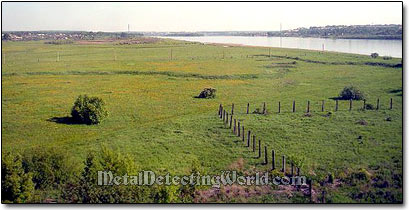
Crop marks appear due to the difference in vegetation growth which is controlled by the soil condition. For instance, a buried stone wall will cause the crop above it to grow shorter as the wall pushes water away and occupies the space of the fertile soil. Another example is a buried ditch with a fill containing more organic matter than the natural earth. The rain and underground water will be naturally collected in this sub-surface ditch and nourish the plants growing above; thus, making them taller than the surrounding vegetation.
Differential Growth Following Features Buried Below
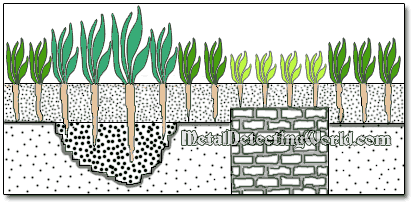
The differences in soil conditions will cause some plants to grow better and therefore taller, and others less strongly and therefore shorter. Some plants will also react through differential ripening of their fruits or their overall color. Particularly effective crops that exhibit differential growth are cereal crops, peas, and potatoes.
Differential growth will naturally follow any features buried below. Although the growth differences may appear small close up, from an elevated point of observation the pattern they make is more visible and differs in tone or color from the normally growing surrounding vegetation. When the sun is low to the horizon, shadows cast by the taller crops can also become visible.
By their nature, crop marks are only visible seasonally and may not be visible at all except in very wet or dry seasons. Droughts can be especially useful to crop mark hunters as the differential growth can become apparent in normally hardy species such as grass. Under the right conditions, normally unseen walking paths and trails may become visible due to the difference between normal soil and compacted soil.
Aerial archaeology is based on spotting the crop marks from the air and has been quite successful in locating the sub-surface archaeological features. Such aerial reconnaissance is one of the most important ways in which new archaeological sites are discovered today. For example, in 2009, investigation of crop marks near Stonehenge revealed a variety of 6,000 year old prehistoric subterranean structures.
SOIL MARKS
Slight differences in soil color between natural deposits and cultural ones can often show in ploughed fields as soil marks. Soil marks are helpful especially in the spring when no vegetation has grown yet, and bare soil is fully exposed to an observer. While looking for the hunt site in the field, pay particular attention to any indications of cultural modifications to the soil that may be an indication of refuse heap deposit.
Cultural Layer
Another good soil clue is the thickness of the dark upper layer - cultural layer or anthropic soil, which, if exists or visible in comparison with natural color of soil on a cut section, represents the depository of all cultural organic matter in addition to ashes and charcoal. The longer the time the former settlement existed at the site, the thicker the cultural layer.
Dark-Colored Upper Layer of Soil Indicates the Cultural Layer
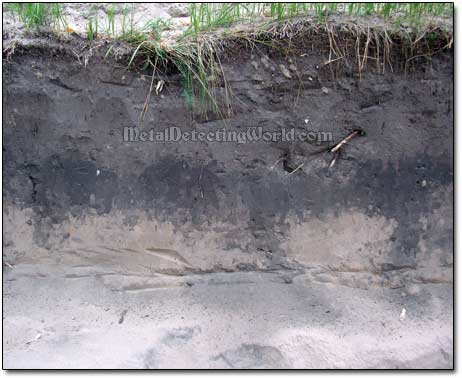
The cultural layer may be thin - 15cm-20cm, like the layer at the site of the 17th century village shown below.
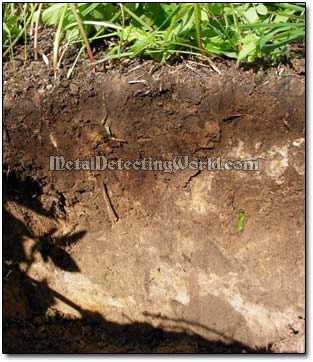
At the older sites such as the sites of medieval villages, the cultural layer may be 50cm-100cm thick.
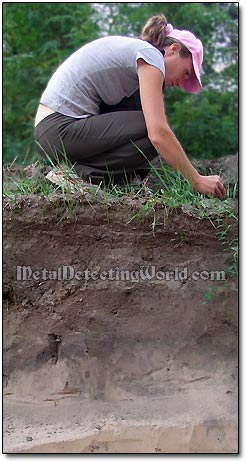
While transecting the field, you can pinpoint the former settlement's location by digging a series of holes at equal intervals. As soon as you notice the dark-colored upper layer on the cut, start digging holes in four directions and find which way the layer's thickness is increasing.
If you spot the brick, shale or pottery fragments in this cultural layer, that will be 100% proof of the former presence of dwellings at this location. Soon you will easily locate the spot with a highest concentration of cultural material - the former settlement's center.
A Brick Fragment Has Been Spotted in Cultural Layer
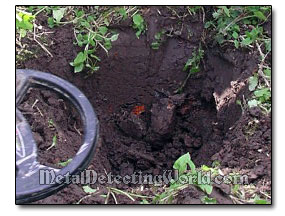
RAIN MARKS
Differences in elevation levels and buried features will also affect the way surface water behaves across a site and can produce a striking effect after heavy rain.
FROST MARKS
Frost marks are the frosted spots that can appear in winter on ploughed fields where water has naturally accumulated along the lines of buried features.
SHADOW MARKS
Shadow marks reveal various forms of cultural features, both on surface (ruins) and sub-surface, and are also more visible from an elevated point of observation or from the air, however they are best viewed obliquely rather than from directly above in order to emphasize the effect of the shadows. Unlike crop marks, frost marks and soil marks they require slightly elevated and upstanding features to work with.
Shadow marks are caused by the differences in height on the ground produced by structural remains. In the case of ancient, eroded earthworks these differences are often small and they are most apparent when viewed from the air, when the sun is low over the horizon. This causes long shadows to be cast by the higher features, which are illuminated from one side by the sun, with dark shadows marking hollows and depressions on another side.